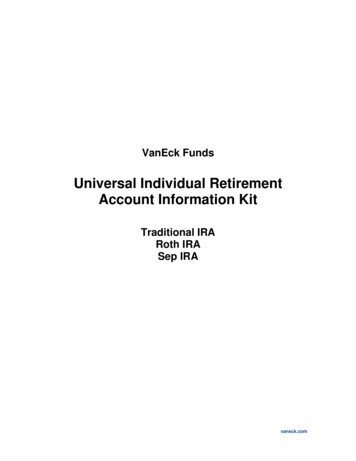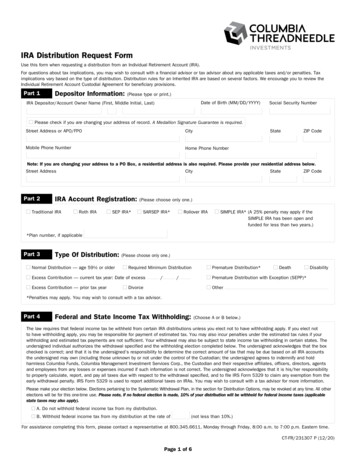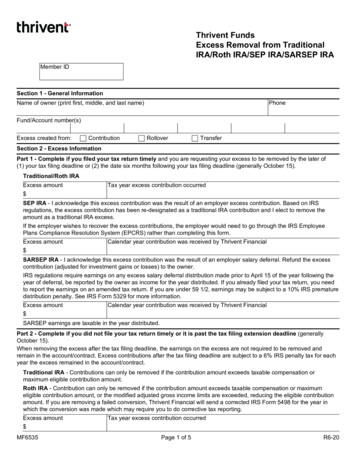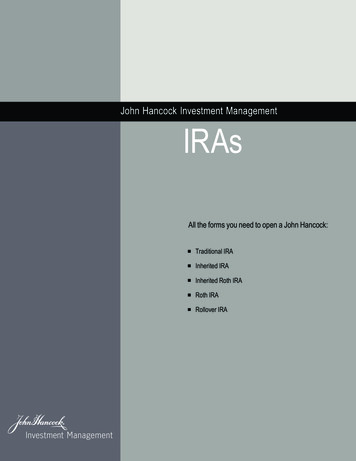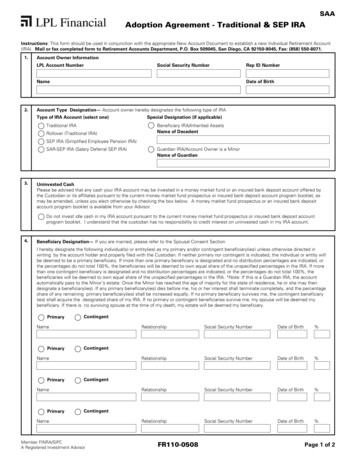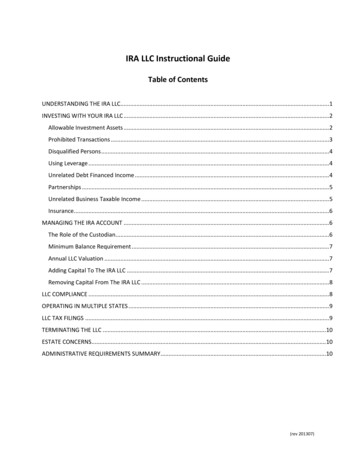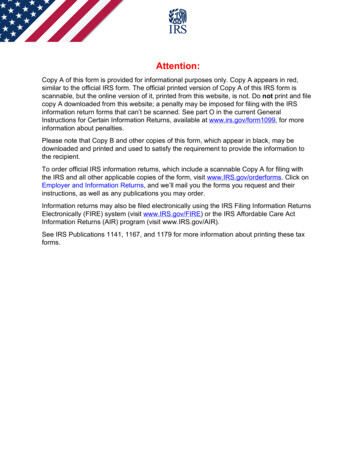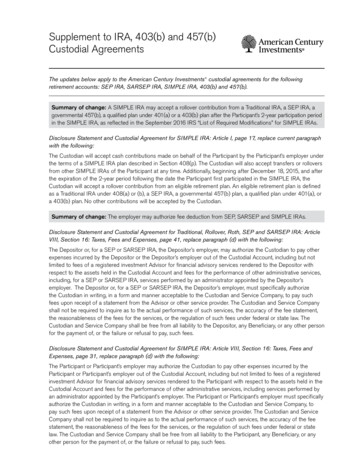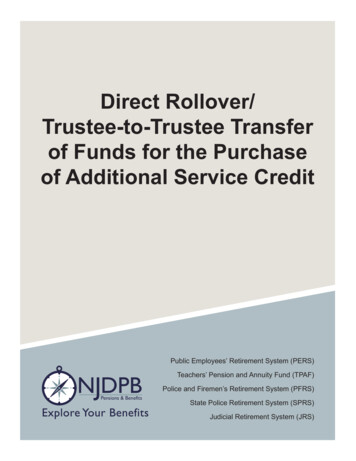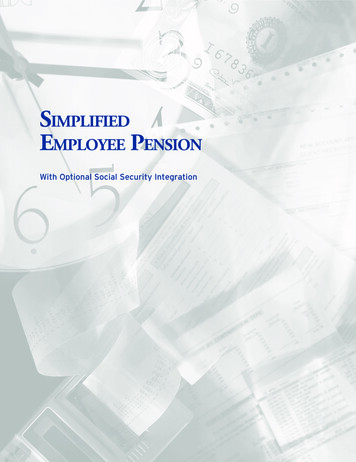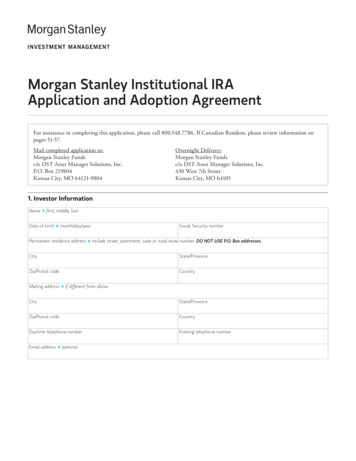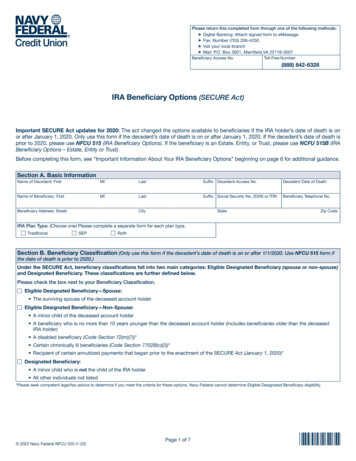
Transcription
This document contains both information and form fields. To read information, use the Down Arrow from a form field.ClearPlease return this completed form through one of the following methods: Digital Banking: Attach signed form to eMessage Fax: Number (703) 206-4250 Vsit your local branch Mail: P.O. Box 3001, Merrifield,VA 22119-3001Beneficiary Access No.Toll-Free Number:(888) 842-6328IRA Beneficiary Options (SECURE Act)Important SECURE Act updates for 2020: The act changed the options available to beneficiaries if the IRA holder’s date of death is onor after January 1, 2020. Only use this form if the decedent’s date of death is on or after January 1, 2020. If the decedent’s date of death isprior to 2020, please use NFCU 515 (IRA Beneficiary Options). If the beneficiary is an Estate, Entity, or Trust, please use NCFU 515B (IRABeneficiary Options – Estate, Entity or Trust).Before completing this form, see “Important Information About Your IRA Beneficiary Options” beginning on page 6 for additional guidance.Section A. Basic InformationName of Decedent: FirstMILastSuffix Decedent Access No.Decedent Date of DeathName of Beneficiary: FirstMILastSuffix Social Security No. (SSN) or ITINBeneficiary Telephone No.Beneficiary Address: StreetCityStateZip CodeIRA Plan Type: (Choose one) Please complete a separate form for each plan type. Traditional SEP RothSection B. Beneficiary Classification (Only use this form if the decedent’s date of death is on or after 1/1/2020. Use NFCU 515 form ifthe date of death is prior to 2020.)Under the SECURE Act, beneficiary classifications fall into two main categories: Eligible Designated Beneficiary (spouse or non-spouse)and Designated Beneficiary. These classifications are further defined below.Please check the box next to your Beneficiary Classification. Eligible Designated Beneficiary—Spouse: The surviving spouse of the deceased account holder Eligible Designated Beneficiary—Non-Spouse: A minor child of the deceased account holder A beneficiary who is no more than 10 years younger than the deceased account holder (includes beneficiaries older than the deceasedIRA holder) A disabled beneficiary (Code Section 72(m)(7))* Certain chronically ill beneficiaries (Code Section 7702B(c)(2))* Recipient of certain annuitized payments that began prior to the enactment of the SECURE Act (January 1, 2020)* Designated Beneficiary: A minor child who is not the child of the IRA holder All other individuals not listed*Please seek competent legal/tax advice to determine if you meet the criteria for these options. Navy Federal cannot determine Eligible Designated Beneficiary eligibility. 2022 Navy Federal NFCU 520 (1-22)Page 1 of 7
Section C. Traditional, SEP, and Roth IRA Instructions (Select from the options under your Beneficiary Classification.)Eligible Designated Beneficiary—Spouse (Choose one option below.)Date of Death Prior to Required Beginning Date (RBD)*and All Roth IRAsDate of Death on or After Required Beginning Date (RBD)* Lump Sum Distribution Option - I elect to receive the IRA planbalance in one single sum. . Lump Sum Distribution Option - I elect to receive the IRA planbalance in one single sum. 10-Year Option - I elect to deplete the IRA plan balance byDecember 31 of the year containing the tenth anniversary of myspouse’s death. 10-Year Option - I elect to deplete the IRA plan balance byDecember 31 of the year containing the tenth anniversary of myspouse’s death. Treat as Own Option - I elect to roll over or transfer the IRA planbalance into my own IRA. (If you elect Treat as Own, you musthave the same IRA plan open as the beneficiary IRA plan. If you donot have the same IRA plan open, please complete and return theappropriate IRA application with this form (Traditional–NFCU 602;Roth–NFCU 602A; or SEP-NFCU 602C).) Treat as Own Option - I elect to roll over or transfer the IRA planbalance into my own IRA. (If you elect Treat as Own, you musthave the same IRA plan open as the beneficiary IRA plan. If you donot have the same IRA plan open, please complete and return theappropriate IRA application with this form (Traditional–NFCU 602 orSEP-NFCU 602C).) Life Expectancy Payment Option (Select from your IRA plan.) Life Expectancy Payment Option (Select from your IRA plan.) Roth IRA only - I elect to deplete the IRA plan balance bytaking payments over my life expectancy. I understand thesepayments must begin no later than December 31 of the yearafter my spouse’s death. Traditional and SEP IRAs only - I elect to deplete the IRAplan balance by taking Life Expectancy Payments beginningno later than December 31 of the year after my spouse’s dateof death. I elect to deplete the balance: Traditional and SEP IRAs only - I elect to deplete the IRAplan balance by taking payments over my own life expectancy.I elect to begin these payments: over my own life expectancy. I am older than my spouse and elect to deplete the planbalance using the life expectancy of my spouse in theyear of death. the year following the year of my spouse’s death. the year in which my spouse would have turned 72.Eligible Designated Beneficiary—Non-Spouse (Choose one option below.)Date of Death Prior to Required Beginning Date (RBD)*and All Roth IRAsDate of Death on or After Required Beginning Date (RBD)* Lump Sum Distribution Option - I elect to receive the IRA planbalance in one single sum. Lump Sum Distribution Option - I elect to receive the IRA planbalance in one single sum. 10-Year Option - I elect to deplete the IRA plan balance byDecember 31 of the year containing the tenth anniversary ofthe IRA holder’s death. 10-Year Option - I elect to deplete the IRA plan balance byDecember 31 of the year containing the tenth anniversary ofthe IRA holder’s death. Life Expectancy Payment Option** (Select from your IRA plan.) Life Expectancy Payment Option** (Select from your IRA plan.) Roth IRA only - I elect to deplete the IRA plan balance bytaking payments over my life expectancy. I understand thesepayments must begin no later than December 31 of the yearafter the IRA holder’s death. Traditional and SEP IRAs only - I elect to deplete the IRAplan balance by taking payments over my own life expectancy. Ielect to begin these payments: the year following the year of the IRA holder’s death. Traditional and SEP IRAs only - I elect to deplete the IRAplan balance by taking Life Expectancy Payments beginning nolater than December 31 of the year after the IRA holder’s dateof death. I elect to deplete the balance: over my own life expectancy. I am older than the IRA holder and elect to deplete theplan balance using the life expectancy of the IRA holderin the year of death. the year in which the IRA holder would have turned 72.Designated Beneficiary (Choose one option below.) Lump Sum Distribution Option - I elect to receive the IRA plan balance in one single sum. 10-Year Option - I elect to deplete the IRA plan balance by December 31 of the year containing the tenth anniversary of the IRA holder’s death.*Required Beginning Date (RBD) – April 1st of the year after the decedent reached age 70½ (date of birth on or before June 30, 1949) or age 72 (date of birth on or after July 1, 1949).**If Life Expectancy Payment option is elected and the Eligible Designated Beneficiary is the minor child of the deceased IRA holder, this option will convert to the 10-Year Optionupon age of majority. The full balance of the IRA plan must then be depleted by December 31 of the 10th year after the minor child reaches age of majority. 2022 Navy Federal NFCU 520 (1-22)Page 2 of 7
Section D. Distribution Instructions (Choose your disbursement schedule below.) Skip this section if you elected Treat as Own (Spouse).Frequency: Monthly Quarterly* AnnuallyDate to Begin Distributions (MM/DD/YY) Lump Sum*Distributions will be made on 3/30, 6/30, 9/30, and 12/28.Transfer to Navy Federal Certificate for a Term of (minimum balance required)Transfer to Navy Federal Account No.Send Check Payable To**Address: StreetCityName(s) on Account (if applicable)StateZip CodeAccount No. at Other Financial Institution (If applicable)**If you are requesting a Direct Transfer, you must contact your financial institution for the appropriate transfer paperwork to accompany this form.Section E. Federal Tax WithholdingWithdrawals and distributions from the IRA are subject to required federal income tax withholding unless you check the “No Withholding”box. If neither box is checked, Navy Federal will withhold 10% of the withdrawal for federal tax. Qualified withdrawals from a Roth IRAare not taxable.Non-qualified withdrawals from a Roth IRA may be taxable.If you elect not to have withholding applied to your withdrawals, you may be responsible for payment of estimated tax. You may incur penaltiesunder the estimated tax rules if your withholding and estimated tax payments are not sufficient. No Withholding: DO NOT withhold any portion of the proceeds from my IRA/SEP accounts for federal taxes Withhold Federal Tax: Elect the following percentage to be withheld for federal tax purposes: % (not less than 1.00%)Section F. State Tax Withholding. Important: Please review the state tax requirements on page 5 for your state carefully beforecompleting your state withholding election.Navy Federal can only withhold for the states listed on page 5 and the District of Columbia. Navy Federal cannot withhold an amount lessthan the required minimum for your state. If no state tax withholding instructions are provided, we are required to withhold the minimumstate tax based on your state on record with Navy Federal. No State Tax Withholding: Do not withhold any state tax from the IRA distribution** State Tax (excluding CA and VT): Withhold % of the distribution for state income tax California and Vermont State Tax Only: Withhold % of the Federal Tax withheld for state income tax**Connecticut (CT) and Michigan (MI) residents must complete and return your state tax form with this form to waive state withholding. (CT: Form CT-W4P) or (MI:Form MI-W-4P)Section G. Required Signatures and Tax CertificationTax Certification (This certification does not apply if I have checked the box below my signature.)Under penalty of perjury, I certify that (1) the SSN/ITIN provided is correct, (2) I am not subject to backup withholding, and (3) I am a USCitizen or US resident alien.The FATCA code certification does not apply.I certify that I am an eligible beneficiary on this IRA and that I am authorized to make this election. The Trustee or Custodian, or any futureTrustee or Custodian, can rely on this election. I certify that all information provided by me is true and accurate. No tax advice has beengiven to me by the Trustee or Custodian. All decisions regarding this election are my own. I expressly assume the responsibility for anyadverse consequences that may arise from this election, and I agree that the Trustee or Custodian shall in no way be held responsible.By signing, I/we acknowledge that I/we have read and agree to the information/disclosure above.Date (MM/DD/YY)Signature By checking this box, I certify that I am a non-resident alien and I have completed a Form W-8BEN. 2022 Navy Federal NFCU 520 (1-22)Page 3 of 7
Section G. Withholding Notice Information (Form W-4R/OMB No. 1545-0074)Basic Information About Withholding From IRAs. Generally, federalincome tax withholding applies to payments made from IRAs.Purpose of Form W-4R. Unless you elect otherwise, federal incometax will be withheld from payments from IRAs. You can use IRS FormW-4R or a substitute form, such as that contained on this form furnishedby the Trustee or Custodian, to instruct your Trustee or Custodian towithhold no tax from your IRA payments (or to revoke this election). Thissubstitute form should be used only for distributions from IRAs that arepayable upon demand.Non-Periodic Payments. Payments from IRAs that are payable upondemand are treated as non-periodic payments for federal income taxpurposes. Generally, non-periodic payments must have income taxwithheld at a rate not less than 10%.You can elect to have no income tax withheld from a non-periodicpayment (IRA payment) by filing IRS Form W-4R or a substitute formwith the Trustee or Custodian and checking the appropriate box on thatform. Your election will remain in effect for any subsequent distributionsunless you change or revoke it.A U.S. citizen or resident alien may not waive withholding on anydistribution delivered outside the U.S. or its possessions. Distributionsto a nonresident alien are generally subject to a tax-withholding rateof 30%. A reduced withholding rate, including exemption, may apply ifthere is a tax treaty between the nonresident alien’s country of residence 2022 Navy Federal NFCU 520 (1-22)and the United States, and the nonresident alien submits Form W-8BEN,Certificate of Foreign Status of Beneficial Owner for United States TaxWithholding, or satisfies the documentation requirements as providedunder the regulations.For more information, please see Publication 505, Tax Withholding andEstimated Tax, and Publication 515, Withholding of Tax on NonresidentAliens and Foreign Entities, available from most IRS offices.Caution: Remember that there are penalties for not paying enough taxduring the year, through either withholding or estimated tax payments.New retirees should see Publication 505. It explains the estimated taxrequirements and penalties in detail. You may be able to avoid quarterlyestimated tax payments by having enough tax withheld from your IRAusing IRS Form W-4R.Revoking the Exemption From Withholding. If you want to revokeyour previously filed exemption from withholding, file another IRS FormW-4R with the Trustee or Custodian and check the appropriate box onthat form.Statement of Income Tax Withheld From Your IRA. By January 31 ofnext year, you will receive a statement from your Trustee or Custodianshowing the total amount of your IRA payments and the total federalincome tax withheld during the year. Copies of IRS Form W-4R will notbe sent to the IRS by the Trustee or Custodian.Page 4 of 7
State Tax Withholding Information SheetThis information is not intended to provide you with complete withholding rules and regulations for state tax withholding. Navy Federalmakes every effort to obtain information about state tax law from state revenue authorities, and every effort has been made to ensure itsaccuracy. Because state tax laws are subject to change, often without prior notice, the accuracy of the information cannot be guaranteedbeyond the revision date of the form. Seek professional tax advice if you have questions regarding state withholding requirements that applyto your Traditional and/or SEP IRA distribution. State tax is not required for Roth IRA distributions.IMPORTANT: Please review the below requirements for your state carefully before completing your state withholdingelection. Navy Federal can only withhold for the following listed states and District of Columbia. Navy Federal cannotwithhold an amount less than the required minimum for your state. If no election is made, the minimum withholding willbe taken based on your state on record with Navy Federal.Arkansas (AR): The minimum withholding rate is 3.00% of the distribution amount. Withholding is mandatory if electing to have Federal taxwithheld. AR state tax can be waived or increased.California (CA): The minimum withholding rate is 10.00% of the Federal tax withheld amount. CA state tax can be waived or increased. Theamount of withholding cannot be less than 10.Connecticut (CT): The minimum withholding rate is 6.99% of the distribution amount. Withholding is mandatory for lump sum distributions ofthe full IRA plan balance and cannot be waived. For other than lump sum distributions of the full IRA plan balance, CT state tax can be waivedor increased. CT requires completing and returning form CT-W4P to waive withholding. NOTE: If you have a CT-W4P form requestingto waive on file with Navy Federal, and it is your last election, you do not need to submit a new CT-W4P form to waive withholding.Delaware (DE): The minimum withholding rate is 5.00% of the distribution amount. Withholding is mandatory if electing to have Federal taxwithheld. DE state tax cannot be waived if Federal tax is withheld. DE state tax can be increased.District of Columbia (DC): Withholding is mandatory at a rate of 8.95% for lump sum distributions of the full IRA plan balance. Thiswithholding cannot be waived. Withholding on partial IRA distributions is not allowed.Iowa (IA): The minimum withholding rate is 5.00% of the distribution amount. Withholding is mandatory if electing to have Federal taxwithheld. IA state tax cannot be waived if Federal tax is withheld. IA state tax can be increased.Kansas (KS): The minimum withholding rate is 5.70% of the distribution. Withholding is mandatory if electing to have Federal tax withheld.KS state tax can be waived or increased.Maine (ME): The minimum withholding rate is 5.00% of the distribution. Withholding is mandatory if electing to have Federal tax withheld.ME state tax can be waived or increased.Massachusetts (MA): The minimum withholding rate is 5.00% of the distribution. Withholding is mandatory if electing to have Federal taxwithheld. MA state tax cannot be waived if Federal tax is withheld. MA state tax can be increased.Michigan (MI): The minimum withholding rate is 4.25% of the distribution. MI state tax can be waived or increased. MI requires completingand returning form MI-W-4P to waive withholding. NOTE: If you have a MI-W-4P form requesting to waive on file with Navy Federal, andit is your last withholding election, you do not need to submit a new MI-W-4P form to waive withholding.Nebraska (NE): The minimum withholding rate is 5.00% of the distribution. Withholding on premature distributions is not allowed regardlessof Federal tax election. For other than premature distributions, NE state withholding is mandatory if Federal tax is withheld and cannot bewaived. NE state tax can be increased.North Carolina (NC): The minimum withholding rate is 4.00% of the distribution. Withholding is mandatory if electing to have Federal taxwithheld. NC state tax can be waived or increased.Oklahoma (OK): The minimum withholding rate is 5.00% of the distribution. Withholding is mandatory if electing to have Federal taxwithheld. OK state tax cannot be waived if Federal tax is withheld. OK state tax can be increased.Oregon (OR): The minimum withholding rate is 8.00% of the distribution. Withholding is mandatory if electing to have Federal tax withheld.OR state tax can be waived or increased. The amount of withholding cannot be less than 10.Vermont (VT): The minimum withholding rate is 30.00% of the Federal tax withheld amount. Withholding is mandatory if electing to haveFederal tax withheld. VT state tax cannot be waived if Federal tax is withheld. VT state tax can be increased.Virginia (VA): The minimum withholding rate is 4.00% of the distribution amount. VA state tax can be waived or increased. 2022 Navy Federal NFCU 520 (1-22)Page 5 of 7
Important Information About Your IRA Beneficiary Options (SECURE Act)Important SECURE Act updates for 2020: The act changed the optionsavailable to beneficiaries when the IRA holder’s date of death is on orafter January 1, 2020. If the IRA holder’s date of death was on or beforeDecember 31, 2019, please use NFCU 515 (IRA Beneficiary Options).1) Eligible Designated Beneficiary Options:You have been named as the beneficiary of an IRA. This InformationSheet has been created to aid you in understanding your options andother issues related to an IRA beneficiary. Please read this informationbefore completing the form.IRA beneficiaries are individuals designated by the IRA holder to receivethe IRA funds in the event of the IRA holder’s death. There are two typesof beneficiaries:1) Primary: The beneficiary first in order to receive the decedent’sIRA funds. If more than one primary beneficiary is designated,the IRA will be divided among the individuals as specified by thedeceased IRA holder, which could include an equal share or setpercentage of the total assets of the IRA.2) Contingent: The contingent beneficiary(ies) is/are next in line toreceive the IRA funds if all primary beneficiaries predecease theaccount holder. Treat as Own (SPOUSE ONLY): You may treat the IRA asyour own. For Traditional and SEP IRAs, your spouse’s yearof death Required Minimum Distribution (if applicable) mustbe removed prior to transferring the IRA to the spouse. ForRoth IRA qualified distribution purposes, you will receivecredit for the number of years your spouse owned the RothIRA prior to death. The age of the deceased Roth IRA holderdoes not apply because Roth IRAs have no required minimumdistributions and no required beginning date. The IRA shouldbe transferred or rolled to an IRA account in your name. Ifyou elect the Treat as Own option, you must have the sameIRA plan open as the beneficiary IRA plan. If you do not havethe same IRA plan open, please complete and return theappropriate IRA application with this form. (Traditional– NFCU602; Roth–NFCU 602A; or SEP-NFCU 602C) Life Expectancy Distribution (SPOUSE ONLY): Classification of Beneficiaries: There are two main classifications ofbeneficiaries under the SECURE Act. They include Eligible DesignatedBeneficiary and Designated Beneficiary. Eligible Designated Beneficiariesare further defined as Spouse and Non-Spouse. These classificationsare defined as:1) Eligible Designated Beneficiary (eligibility determined on dateof death) The surviving spouse of the IRA account holder The minor child of the IRA holder who has not reached the age ofmajority (at majority, the child becomes a Designated Beneficiary)If your spouse died before the required beginning date, youmust begin to distribute the assets of the spouse’s IRA overyour own recalculated single life expectancy, beginning nolater than December 31 of the later of: the year following the year of your spouse’s death. (Roth,Traditional and SEP IRAs) the year your spouse would have attained age 70½(decedent’s date of birth on or before June 30,1949) orage 72 (decedent’s date of birth on or after July 1, 1949).(Traditional and SEP IRAs only)If your spouse died after the required beginning date, youmust begin to distribute the assets of your spouse’s IRAover your own recalculated single life expectancy, beginningno later than December 31 of the later of: A beneficiary who is not more than 10 years younger than the IRAholder (includes beneficiaries older than the deceased IRA holder) the year following the year of your spouse’s death. (Roth,Traditional and SEP IRAs) Disabled beneficiaries (within the meaning of IRC Code section72(m)(7))* the year your spouse would have attained age 70½(decedent’s date of birth on or before June 30,1949) orage 72 (decedent’s date of birth on or after July 1, 1949).(Traditional and SEP IRAs only) Certain chronically ill individuals (within the meaning of IRCCode 7702B(c)(2))* Recipients of certain annuitized payments that began prior tothe enactment of the SECURE Act*2) Designated Beneficiary A minor child who is not the child of the IRA holder All other ‘person’ beneficiaries not classified as an EligibleDesignated Beneficiary Beneficiary Options: The options available to a beneficiary aredependent on the classification of the beneficiary, the relationship, and insome instances, whether the IRA holder’s death was before or after therequired beginning date** for required minimum distributions. Followingare the respective options for each classification under the SECURE Act.*Please seek competent legal/tax advice to determine if you meet the criteria for theseoptions. Navy Federal cannot determine your eligibility.**Required Beginning Date: April 1st of the year after the decedent reached age 70½(date of birth on or before June 30, 1949) or age 72 (date of birth on or after July 1, 1949). 2022 Navy Federal NFCU 520 (1-22) Life Expectancy Distribution (NON-SPOUSE): If the beneficiaryis the minor child of the deceased IRA holder, this option willconvert to the 10-year option upon age of majority. The fullbalance of the IRA plan must then be depleted by December 31of the 10th year after the minor child reaches the age of majority.Please seek competent tax advice for more information.Page 6 of 7If the IRA holder died before the required beginning date,you must begin to distribute the assets of the decedent’sIRA over your own recalculated single life expectancy,beginning no later than December 31 of the later of: the year following the year of the IRA holder’s death.(Roth, Traditional and SEP IRAs) the year the IRA holder would have attained age 70½(decedent’s date of birth on or before June 30,1949) orage 72 (decedent’s date of birth on or after July 1, 1949).(Traditional and SEP IRAs only)
If the IRA holder died after the required beginning date,you must begin to distribute the assets of the decedent’sIRA beginning no later than December 31 the yearfollowing the year of the IRA holder’s death using your own life expectancy. (Roth, Traditional andSEP IRAs)If you are older than the IRA holder, you may elect todeplete the IRA plan balance using the life expectancyof the IRA holder in the year of death. (Traditional andSEP IRAs only) Ten-Year Option: You must distribute the assets of thedecedent’s IRA plan by December 31, ten years after the dateof death of the IRA holder. This does not mean that 1/10 must bewithdrawn each year. The ten years is a deadline by which youmust distribute the IRA plan in order to avoid a 50% excessaccumulation excise tax. Lump Sum Distribution: You may distribute the entire IRAplan balance. You may owe taxes on the distribution; however,because the funds are being distributed because of death, the10% IRS penalty tax will not apply.2) Designated Beneficiary Options 10-Year Payout: You must distribute the assets of the decedent’sIRA plan by December 31, ten years after the date of deathof the IRA holder. This does not mean that 1/10 must bewithdrawn each year. The ten years is a deadline by which youmust distribute the IRA plan in order to avoid a 50% excessaccumulation excise tax. Lump Sum Distribution: You may distribute the entire IRAplan balance. You may owe taxes on the distribution; however,because the funds are being distributed because of death, the10% IRS penalty tax will not apply.Timing Requirement Instructions: Regardless of which type ofbeneficiary classification, the IRS requires that you (as the IRA beneficiary)provide your distribution instructions to Navy Federal no later thanDecember 31 of the year following the date of death of the IRA holder.For example, if the IRA holder is deceased on May 31, 2019, you will haveuntil December 31, 2020 to provide Navy Federal with your instructions.Additional Information:Beneficiary IRA Account(s): Upon receipt of a death certificate for an IRAholder, Navy Federal will audit the IRA account for named beneficiary(ies).After determining the beneficiary(ies), the remaining IRA proceeds will beplaced into a temporary beneficiary IRA account, where they will remainuntil Navy Federal receives your instructions. The temporary accountwill contain the name of the beneficiary(ies) and their respective SocialSecurity Number(s). No beneficiaries may be named on such an account,so if the beneficiary dies while the IRA funds are in this account, the IRAassets will go to the beneficiary’s estate. Additional specifics about thistemporary account include the following: This is a temporary account for the purpose of holdingIRA assets in the interim of receiving instructions from thebeneficiary. New beneficiaries cannot be named to thistemporary account.Taxation of IRA Distribution to an IRA Beneficiary: Funds distributedfrom the IRA by a beneficiary may be considered income in the year theyare distributed and included in income for taxation purposes. A spousebeneficiary may roll the proceeds into their own IRA, thereby avoidingdistribution of the assets from the IRA. Please seek competent tax advicewhen considering this aspect.Methods of Distribution: Navy Federal has many flexible options. Youcan elect to distribute annually, quarterly, or monthly. In addition,you may request for the funds to be distributed directly to your savingsaccount, checking account, or MMSA at Navy Federal (Navy Federalmembers only) or have the funds sent via check to your home addressor directly to another financial institution.Beneficiary Disclaimers: An individual who is entitled to receivedeath benefits from an IRA may file a disclaimer with Navy Federal,renouncing all or a portion of their interest in the IRA. In such case, thedisclaimed assets pass as if the disclaiming beneficiary had died beforethe IRA owner.A disclaimer cannot be used to direct the death benefits to a selectedperson. The disclaimed interest must pass to another eligible designatedor designated beneficiary (based on the beneficiary designation form orthe IRA plan agreement default, whichever applies).A beneficiary may disclaim his or her rights only if all the following are met. A qualified disclaimer must be a written, irrevocable refusalto accept interest in the given property. Thus, the beneficiarycannot change his/her mind after signing the disclaimer. The disclaimer must be provided to Navy Federal within thelater of: nine (9) months after the IRA owner’s death, or nine (9) months after the date on which the beneficiaryturns age 21.When a trust or estate is named as the beneficiary and those individualsthat benefit from the trust or estate choose to disclaim an interest in anIRA, each individual must make a disclaimer. A collective disclaimer madeby an executor on behalf of the es
(SECURE Act) Important SECURE Act updates for 2020: The act changed the options available to beneficiaries if the IRA holder's date of death is on or after January 1, 2020. Only use this form if the decedent's date of death is on or after January 1, 2020. If the decedent's date of death is prior to 2020, please use . NFCU 515
